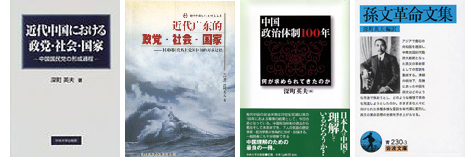Top>Opinion>Why Has a Jasmine Revolution Not Occurred in China? The 100th Anniversary of the Xinhai Revolution
 Index
Index

Hideo Fukamachi [Profile]
Why Has a Jasmine Revolution Not Occurred in China? The 100th Anniversary of the Xinhai Revolution
Hideo Fukamachi
Professor, Faculty of Economics, Chuo University
Area of Specialization: Chinese Political History
The Jasmine Revolution misfires in China
The collapse of the Qaddafi administration in Libya seemingly represents a milestone in the series of The Arab spring continuing since the end of the last year. During this period, many have often expected how it would influence China, where a dictatorship has also persisted for a long time. In fact, the Chinese Jasmine Revolution was called for on the Internet several times from this February through March, but all of such attempts failed eventually under the authorities' strict alert.
After that, in relation to the high-speed railway accident this July, criticism for the authorities' response to the accident exploded not only from victims' families but also from the public throughout the nation. Some of the Japanese media reported it as if a Jasmine Revolution was ready to occur in China. That was revealed, however, to be nothing more than wishful thinking, which has arisen and disappeared repeatedly in the past.
While dissatisfaction against the widening gap between the rich and the poor and widespread corruption of the bureaucracy-the dark side of the rapid economic development-cause protest and riots from the masses around the country, a significant number of democratic intellectual activists including Nobel Peace Prize laureate Liu Xiaobo are in prison or are under surveillance by the authorities-this might be the image of modern China often reported globally. So, why does a Jasmine Revolution not occur in China in spite of these conditions?
China was an advanced democracy
By a curious coincidence, China celebrates the 100th anniversary of the Xinhai Revolution this year. It is the 100th year since a republic was established for the first time in Asia after the breakdown of the tyrannical dynasty regime that had lasted for several millennia, triggered by the armed uprising that broke out in Wuhan, Hubei province, on October 10th, 1911. Various memorial events were held around China, and I also attended a large international conference in Wuhan in mid-October, which can be regarded as something like a national event. Also in Japan, international academic meetings will be held in Tokyo and Kobe in December (http://www.shingai100japan.jp![]() ).
).
Some media reports in Japan related to the 100th anniversary of the Xinhai Revolution said "Among the Three Principles of the People-nationalism, democracy, and the people's welfare or livelihood-advocated by revolution leader Sun Yat-sen, democracy has not been achieved yet." This might imply that "China, therefore, should experience a Jasmine Revolution." If so, I need to point out that an important fact is ignored. That is, the single-party regime in modern China is not a transitional system before democratization, but was chosen based on the experience of failure in democracy.
The Republic of China, which was established through the Xinhai Revolution, adopted a parliamentary system. In the national election held immediately after that from the end of 1912 to the beginning of 1913, the ratio of constituency among the total population reached over 10 percent under limited suffrage. For comparison, this ratio in Japan was 2.2 percent in 1900 and merely 5.5 percent in 1919, and finally reached 20 percent due to universal male suffrage in 1925. In other words, China was once about to become an advanced parliamentary democracy, 100 years ago.
Chinese chose a dictatorship
However, the democratic regime in the Republic of China was unstable, and fell into a situation that was described as warlords competing with each other. Then the Chinese Nationalist Party formed by Sun Yat-sen established the Party-State regime, where a dominant single party ruled the administration. This regime was succeeded and completed by the Communist Party, which established the People's Republic of China. Because this totalitarian control and mobilization caused not only economic and cultural stagnation but even turmoil in the social order and the state administration, however, China shifted to the Reform-and-Opening line since 1978, which finally achieved relative stability in governance.
In other words, China is achieving a rich and powerful state and nation-which has been their ardent wish for 100 years-under the current authoritarian government, which is an intermediate regime chosen after a history of chaos and destruction caused by two extreme political regimes, democracy and totalitarianism. This achievement of the current administration is generally recognized by the Chinese people, and is apparently the very foundation of governmental legitimacy for the regime (please read my books below for detail).
In China today, a significant amount of criticism is leveled against individual policies, and it is the people themselves who acutely realize the adverse effects of the dictatorship. Nevertheless, only an extremely limited minority calls for fundamental transformation in the political regime. Whereas it is out of the question to return to purer dictatorship-i.e., totalitarianism-introduction of democracy tends to be considered as something negative that might engender inefficiency or disorder. In short, many Chinese people have chosen the current limited dictatorship as a sort of necessary evil.
What prevents a Chinese Jasmine Revolution?
Some often argue that the current situation where riots occur frequently is similar to one in the final phase of the traditional dynasties and is a sign of the collapsing Communist regime. However, I cannot readily agree to such an argument. There was room in the traditional Chinese society for the emergence of secret sects and revolutionary forces that were so powerful as to have the potential to overthrow the dynasty, because the governing apparatus of the traditional dynasties was too small for the size of the land and population, and its governance was lax. On the other hand, I wonder whether the contemporary Chinese society where the Communist organization is penetrating so widely and deeply has an aperture for forming forces that have the ability to counter it.
Today, the Communist Party has about 80 million members, and approximately the same number of people belongs to its subjacent organization Communist Youth League. The combined membership totals over 10 percent of 1.3 billion, the total population in China. As a result, one of several Chinese people is a person related to the Communist Party in a broad sense, including party members' relatives. Not all of them enjoy wealth and power, of course, and they may not necessarily be monolithic. Such a huge government organization is very unique in the world, however, as well as unprecedented even in Chinese history.
In general, the Chinese are inclined to aim at so-called stealing a march, attempting to have a share in national control by approaching the power vertically, instead of uniting horizontally on a region or social class basis to challenge the power. This makes mass protest movements vulnerable to undermined solidarity and usually less persistent and uncooperative with each other. I consider that such nature of the Chinese society has driven the expansion of the massive Communist organization mentioned above as well as discouraged outbreak of a Chinese Jasmine Revolution.
- Hideo Fukamachi
Professor, Faculty of Economics, Chuo University
Area of Specialization: Chinese Political History - Professor Fukamachi was born in Tokyo in 1966. He graduated from the Department of Aesthetics, Division of Philosophy, Faculty of Letters, Kyoto University in 1988. He studied for one year from 1994 at the Ph.D. program in History and East Asian Language, Graduate School of Arts and Sciences, Harvard University, and graduated from the Doctoral Program, Graduate School of Area and Cultural Studies, Tokyo University of Foreign Studies with a Ph.D. degree. He then served as a full-time lecturer and an Associate Professor, Faculty of Economics, Chuo University before assuming his current position in 2004 (also a visiting fellow, Hoover Institution, Stanford University from 2004 to 2006). Professor Fukamachi's major publications include Party, Society, and the State in Modern China: The Making of the Chinese Nationalist Party [Kindai Chugoku ni okeru Seito, Shakai, Kokka: Chugoku Kokuminto no Keisei Katei]; Party, Society, and the State in Modern Guangdong: The Making of the Chinese Nationalist Party and Its Party-State Regime; 100 Years of China's Political Regimes: What has been pursued? [Chugoku Seiji Taisei 100 Nen: Nani ga Motomerarete kitanoka]; and A Revolution Anthology of Sun Yat-sen [Sonbun Kakumei Bunshu].
-
Hideo Fukamachi, Party, Society, and the State in Modern China: The Making of the Chinese Nationalist Party [Kindai Chugoku ni okeru Seito, Shakai, Kokka: Chugoku Kokuminto no Keisei Katei], Chuo University Press, 1999.

Hideo Fukamachi, Party, Society, and the State in Modern Guangdong: The Making of the Chinese Nationalist Party and Its Party-State Regime, Social Sciences Academic Press, 2003.
Hideo Fukamachi, ed., 100 Years of China's Political Regimes: What has been pursued? [Chugoku Seiji Taisei 100 Nen: Nani ga Motomerarete kitanoka], Chuo University Press, 2009.
Hideo Fukamachi, trans. and ed., A Revolution Anthology of Sun Yat-sen [Sonbun Kakumei Bunshu], Iwanami Bunko, 2011.

- Research Activities as a Member of Research Fellowship for Young Scientists (DC1), Japan Society for the Promotion of Science (JSPS) Shuma Tsurumi
- Important Factors for Innovation in Payment Services Nobuhiko Sugiura
- Beyond the Concepts of Fellow Citizens and Foreigners— To Achieve SDGs Goal 10 “Reduce Inequality Within and Among Countries” Rika Lee
- Diary of Struggles in Cambodia Fumie Fukuoka
- How Can We Measure Learning Ability?
—Analysis of a Competency Self-Assessment Questionnaire— Yu Saito / Yoko Neha - The Making of the Movie Kirakira Megane








